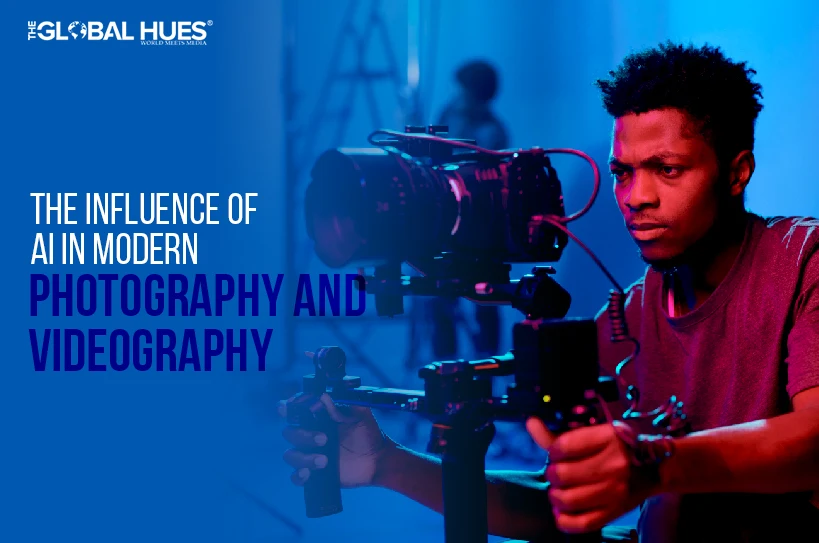Generative AI is the most powerful tool for creativity ever created. It has the potential to unleash a new era of human innovation. – a famous quote from Elon Musk.
From automated design algorithms to AI-driven music creation, the incorporation of AI has altered traditional procedures, allowing creatives to push the limits of their work. Historically, the transition from conventional to digital photography and videography represented a tremendous advancement(and some debate) in the visual arts. AI is already speeding up this progression, allowing for unique creativity and accessibility in photography and filmmaking.
AI’s influence on modern photography and videography is considerable, resulting in significant advances in both arts. According to recent research, marketers predict the worldwide AI industry in media and entertainment will reach $99.48 billion by 2030, indicating an increasing dependence on AI-driven technologies. These tools augment the sector rather than simply enhance it. For instance, below are the different influences of AI in visual arts.
AI in Photography
1. AI-Driven Cameras and Smartphones
AI improvements in smartphone cameras have enabled people to create professional-quality photographs with little effort, democratizing photography and broadening creative possibilities. Computational photography, a vital AI-driven feature, merges numerous photos to improve clarity and detail. Real-time scene identification and optimization enable smartphones to automatically modify settings based on the scene, whether in portrait, landscape, or low-light conditions.
In DSLR and mirrorless cameras, AI has enabled professional photographers to capture complex scenes more efficiently and accurately. Advanced artificial intelligence algorithms evaluate the scene and automatically change focus points, creating clear and precise photographs even in fast-paced or uncertain scenarios. AI-powered topic identification enables cameras to track and concentrate on moving subjects, such as sports or animals, with unprecedented accuracy.
2. AI-Powered Editing Tools
AI-powered editing tools save time and allow photographers to concentrate on the creative parts of their work, confident that AI will handle basic corrections. Automated software may improve photographs by altering exposure, contrast, and color equilibrium with a single click. AI is also utilized in portrait photography to provide accurate retouching that enhances natural attractiveness without over-editing. These tools
Generative AI is pushing the limits of photographic creativity by providing one-of-a-kind effects and filters. Style transfer technology, for example, enables photographers to integrate the visual style of one image into another, resulting in new artistic expressions. AI-generated filters may also improve photographs in previously unachievable ways with standard editing software.
3. AI in Image Organization and Curation
Managing enormous picture collections may be difficult, but AI makes it easier by automating tagging, sorting, and categorizing. AI-powered technologies assess image content and assign appropriate tags, allowing for better search and retrieval of specific photos. It is especially beneficial for professional photographers who organize hundreds of photographs from numerous projects.
AI-powered search and retrieval technologies go beyond simple keyword searches, allowing users to locate photos based on the content contained inside them. For example, AI can recognize and extract photographs of a particular person, item, or scene from a large collection. Content-aware suggestions can also assist photographers in editing their portfolios by selecting the finest photographs based on composition, lighting, and other aesthetic criteria.
AI in Videography
1. AI-Enhanced Video Capture
Smart video cameras increasingly use AI to improve video recording, including real-time stabilization and motion tracking for smoother footage. AI-powered scene recognition enables cameras to automatically detect the sort of image the user captures —whether it’s a landscape, portrait, or action shot—and change lighting, exposure, and other settings as needed.
AI is extremely important in current drone technology since it enables autonomous flying and advanced subject tracking for cinematic shots. Drones fitted with AI can precisely track a moving subject, altering their location and camera angles to create dynamic footage that was previously only feasible with a complete crew. Furthermore, AI-powered obstacle recognition and avoidance technologies provide safe flight paths, allowing drones to navigate complicated areas without human assistance.
2. AI-Powered Video Editing
AI-powered video editor tools have innovated post-production by providing software that automatically edits, sequences, and transitions clips with professional accuracy. Real-time video upgrade features such as color correction, eye contact AI, noise reduction, and stabilization technology perform correction automatically, saving time and effort in producing polished films.
In post-production, videographers increasingly used AI for color grading and special effects. AI algorithms may assess a video’s visual features and apply uniform color grading to all sequences, resulting in a coherent look. Another AI advancement, AI voice cloning and deepfake technology, enables the creation of hyper-realistic audio and visual content, such as digitally changed voices and actors or wholly synthetic characters, expanding the possibilities for creative storytelling.
3. AI in Video Content Creation
AI is changing video content by allowing computers to create synthetic actors and surroundings. These AI-generated features may be effortlessly blended with live-action film, resulting in immersive experiences that blur the distinction between reality and digital fabrication. AI-driven animation and CGI (Computer-Generated Imagery) are also quickly evolving, enabling the production of lifelike characters and environments that expand storytelling possibilities.
Furthermore, AI improves live streaming and broadcasting by introducing real-time video upgrades and AI-powered overlays. These technologies enable automated modifications to lighting, color, and sound quality during live broadcasts, resulting in a professional presentation with no operator involvement. AI-powered overlays may display real-time data, images, and other interactive components, making live feeds more appealing to viewers.
The Debate Over AI in Creative Industries
Incorporating AI into creative sectors has provoked heated discussion, notably over worries that AI may replace human creativity. Critics claim that AI’s capacity to automate tasks formerly performed by humans may reduce the importance of professional photographers and videographers, potentially leading to job displacement. Others argue that AI should be viewed as a tool that complements rather than replaces creativity, allowing experts to focus on more complicated and creative parts of their work. The balance between innovation and preserving human creativity is still essential in this continuing discussion.
Final Thoughts
AI’s impact on photography and videography has been innovative, resulting in substantial advances in camera technology, editing tools, and content creation workflows. From AI-enhanced video capture to the ethical issues of AI-driven modification, AI integration is changing the visual arts world. As previously said, the future promises intriguing opportunities. AI is projected to recreate a more significant part in creative collaboration and immersive content development. While obstacles persist, particularly in balancing innovation and ethical issues, AI has enormous potential to improve the creative process, ushering in a new era of visual storytelling.
(DISCLAIMER: The information in this article does not necessarily reflect the views of The Global Hues. We make no representation or warranty of any kind, express or implied, regarding the accuracy, adequacy, validity, reliability, availability or completeness of any information in this article.)



